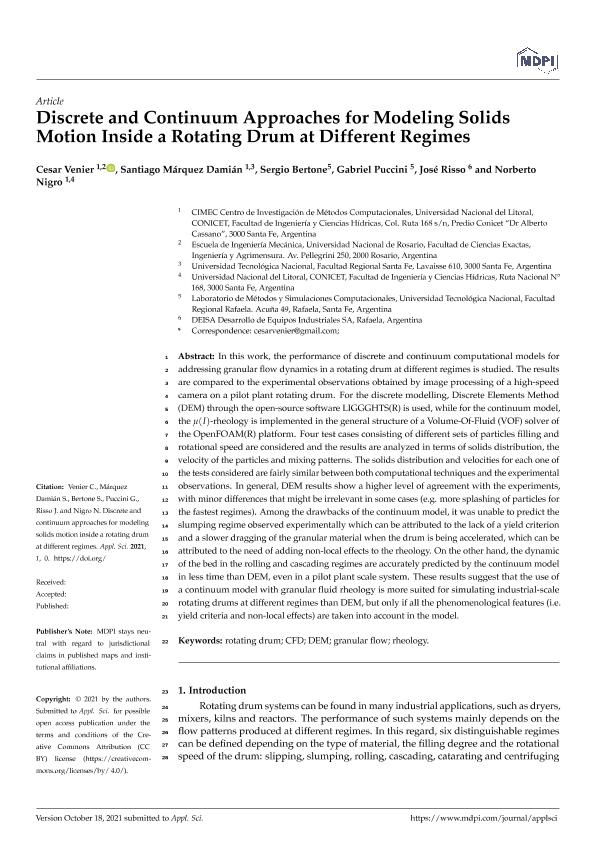Artículo
Discrete and continuum approaches for modeling solids motion inside a rotating drum at different regimes
Venier, César Martín ; Marquez Damian, Santiago
; Marquez Damian, Santiago ; Bertone, Sergio Eduardo; Puccini, Gabriel Darío; Risso, José María; Nigro, Norberto Marcelo
; Bertone, Sergio Eduardo; Puccini, Gabriel Darío; Risso, José María; Nigro, Norberto Marcelo
 ; Marquez Damian, Santiago
; Marquez Damian, Santiago ; Bertone, Sergio Eduardo; Puccini, Gabriel Darío; Risso, José María; Nigro, Norberto Marcelo
; Bertone, Sergio Eduardo; Puccini, Gabriel Darío; Risso, José María; Nigro, Norberto Marcelo
Fecha de publicación:
11/2021
Editorial:
MDPI
Revista:
Applied Sciences (Switzerland)
ISSN:
2076-3417
Idioma:
Inglés
Tipo de recurso:
Artículo publicado
Clasificación temática:
Resumen
In this work, the performance of discrete and continuum computational models for ad-dressing granular flow dynamics in a rotating drum at different regimes is studied. The results are compared to the experimental observations obtained by image processing of a high-speed camera on a pilot plant rotating drum. For the discrete modeling, Discrete Elements Method (DEM) through the open-source software LIGGGHTS(R) is used, while for the continuum model, the µ(I)-rheology is implemented in the general structure of a Volume-Of-Fluid (VOF) solver of the OpenFOAM(R) platform. Four test cases consisting of different sets of particles filling and rotational speed are considered and the results are analyzed in terms of solids distribution, the velocity of the particles, and mixing patterns. The solids distribution and velocities for each one of the tests considered are fairly similar between both computational techniques and the experimental observations. In general, DEM results show a higher level of agreement with the experiments, with minor differences that might be irrelevant in some cases (e.g., more splashing of particles for the fastest regimes). Among the drawbacks of the continuum model, it was unable to predict the slumping regime observed experimentally which can be attributed to the lack of a yield criterion and a slower dragging of the granular material when the drum is being accelerated, which can be attributed to the need of adding non-local effects to the rheology. On the other hand, the dynamic of the bed in the rolling and cascading regimes are accurately predicted by the continuum model in less time than DEM, even in a pilot plant scale system. These results suggest that the use of a continuum model with granular fluid rheology is more suited for simulating industrial-scale rotating drums at different regimes than DEM, but only if all the phenomenological features (i.e., yield criteria and non-local effects) are taken into account in the model.
Palabras clave:
CFD
,
DEM
,
GRANULAR FLOW
,
RHEOLOGY
,
ROTATING DRUM
Archivos asociados
Licencia
Identificadores
Colecciones
Articulos(CIMEC)
Articulos de CENTRO DE INVESTIGACION DE METODOS COMPUTACIONALES
Articulos de CENTRO DE INVESTIGACION DE METODOS COMPUTACIONALES
Citación
Venier, César Martín; Marquez Damian, Santiago; Bertone, Sergio Eduardo; Puccini, Gabriel Darío; Risso, José María; et al.; Discrete and continuum approaches for modeling solids motion inside a rotating drum at different regimes; MDPI; Applied Sciences (Switzerland); 11; 21; 11-2021; 1-23
Compartir
Altmétricas



